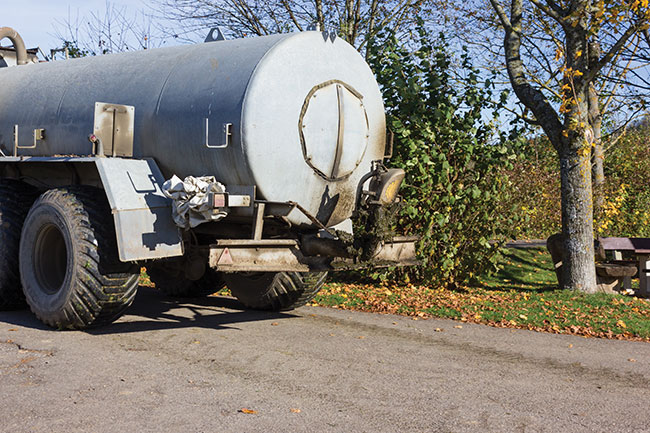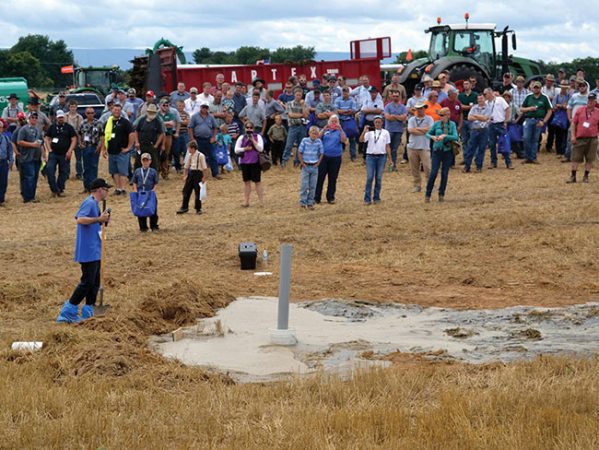
Features
Road safety
Safety
Mitigating risk when moving manure
Tips for safe manure transport and spill response.
December 20, 2022 by James Careless
 Moving manure can seem like a hazardous business, especially with roads busier than ever.
Photo: © rudolfgeiger / adobe stock
Moving manure can seem like a hazardous business, especially with roads busier than ever.
Photo: © rudolfgeiger / adobe stock Moving manure from the farm or manure storage to an application site can seem like a harrowing, hazardous business, especially if it results in a vehicle turnover that loses the load while injuring the driver. But it doesn’t have to be a harrowing or hazardous experience – if you’re well-prepared.
University of Wisconsin Extension (UWEX) regularly updates area applicators and farmers on safety, particularly road safety and spill response, in order to ensure those in the industry are adhering to standardized procedures – and that individuals stay safe.
Check your equipment
A load of manure is heavy and messy to move, and the strain it puts in tractors, trucks and trailers can be too much if they are not in tip-top shape. So to ensure safe manure transport, “make sure that you’ve inspected the equipment at the beginning of the day and walk around several times per day,” says Kevin Erb, director of UWEX’s conservation professional training program.
Points to check include:
- Are the hydraulics and hoses properly connected?
- Did you use the right size hitch pin, and are the safety chains attached?
- Is the tractor large enough to safely stop a loaded spreader?
- Does the spreader have a lid or tarp to prevent splashing/spilling if you have to hit the brakes?
All of these questions need to be answered before departing on your trip – not during.
Worth noting: “A major factor for safety is to make sure that all warning lights and flashers are working on the equipment, and that marking tape and reflectors are visible and in place,” says Jerry Clark, UW-Madison agriculture educator. If drivers can’t see you, they can’t avoid you.
Plan your route carefully
Smart route planning plays an important part in maximizing safety during manure transport, while just setting off to the application site without first planning for potential road and traffic hazards can be a recipe for disaster.
To stay safe, “choose the right route to the field,” says Clark. “A right turn on [or onto] a busy road is easier than a left turn, and safer too. Yes, the safer route may be a mile further and take two minutes longer, but it is worth it. As well, choose loaded routes with less oncoming traffic.”
Another smart traffic tip: Send empty manure haulers along a different route than they used to reach the application site. This will avoid the need for loaded and empty haulers to slow down and pull partly off the road when they meet each other on a shared route.
Drive defensively
“Manure applicators need to adhere to road and traffic laws just like any other vehicle on roads,” says Erb. And, given the potential for damage, pollution and injuries plus negative bad media attention when accidents do occur, he says manure haulers indeed need to be extra careful when moving along public roadways.
Drivers should be aware that operating on the public roads is a major stressor for manure transport drivers, especially when operating on busy public roads with other motorists. “Width of equipment and the fact that most applicator trucks and tractors often operate slower than other vehicles makes for impatient drivers from the public,” explains Clark. “Dust and odor also add stress to applicators as many public drivers don’t appreciate being behind manure application equipment.”
“Other drivers are a huge problem,” says Erb. “They don’t understand why you are driving slowly, that you can’t stop on a dime, that swinging right before turning is not an invitation for them to pass you. So always know what other drivers are behind you, and expect those drivers to cause a problem for you. Drive defensively.”
It also doesn’t hurt to have some form of dash-cam within the cab of the hauling unit, to prove the applicator’s innocence when another driver causes an accident – such as by cutting off the hauler.

University of Wisconsin’s Kevin Erb demonstrates proper manure spill cleanup procedure at a previous North American Manure Expo.
Photo by Manure Manager.
Weather matters
Moving manure can be tough even in good weather. But when the rain or snow comes down, making roads slick and visibility poor, it can add a whole new level of danger to the drive. This is why manure transport drivers need to keep their eyes on the skies (and the weather reports on their smartphones) to anticipate bad weather and avoid driving in it. Keeping the radio tuned to a station with regular weather radio reports, rather than sticking to music or podcasts, is also a smart move.
“Farmers and manure applicators do a very good job operating safely even with very long days,” says Erb. “Where we tend to see more problems is when drivers are both working long days and have the added stress of rain in the forecast or needing to wrap up so they can get to chores or attend an off-farm gathering. That additional stress leads to unconscious safety shortcuts.”
The proof of his point can be found in the accident numbers. “Data from Wisconsin’s drier years shows fewer human error caused spills occurring, but the number goes up in the days before forecasted rain or snow,” says Erb.
Weather-related accidents can also occur during a spring thaw when the frost melts in a dirt roadbed, leaving it weak, soft and potentially hazardous to heavy machinery. “That’s why some states have ‘frost laws’ or seasonal weight limits,” he notes.
Know the limits
Every jurisdiction has its own rules about the maximum allowable weight and dimensions of manure transportation machines/trailers – often classified as “implements of husbandry” (IoH) – and a law-abiding, safety-minded manure transporter always works within these limits.
For instance, in Wisconsin “agricultural weight limits are 23,000 pounds per axle or 92,000 pounds gross vehicle weight (GVW), dependent on number of axles and axle spacing, and subject to seasonal or special postings,” says Clark. “Certain IoH may be given an axle weight exemption on local roads. These higher weight limits are not allowed on interstate highways.”
Every jurisdiction is different when it comes to their IoH rules, so it’s important to be familiar with your state/province’s rules and regulations. As well, “some farm equipment is just too wide, too long, and or too heavy to operate on the road,” says Erb. “It’s not uncommon for a tractor (with no equipment attached) to exceed a state’s per-axle weight limit.”
Manage spills safely
When things go wrong and manure spills do occur, “human safety is more important than environmental safety,” says Erb. “So make sure the driver and all involved receive any medical aid they need first, before you do anything else.”
Next, “if you’re on a busy road, or near a curve, bridge or safety hazard, have the local police block off the road,” he advised. This is common police procedure at accident scenes, because they don’t want a secondary accident to occur. As well, an important aspect of safety management is to limit the number of bystanders and neighbors at the scene who might get in the way of first responders.
Once human safety has been assured, it is time to move onto the five steps of spill control. According to Clark, the proper steps are:
- Control and contain the spill.
- Notify your supervisor.
- Contact appropriate authorities.
- Cleanup the spill.
- Document the spill.
Take breaks and recharge
A long day spent shuttling and applying can be exhausting for applicators. As such, “we recommend that drivers take a break every few loads, like taking a walk around the equipment while it is loading to inspect for common problems,” says Clark. “The biggest stress factor for manure applicators is long work days especially during the busy seasons of spring and fall, when most of the manure is applied before or after the growing season. Equipment breakdowns, weather delays, and fatigue only add to the overall stress of the work and applicator faces.”
This is why “applicators need to eat healthy and try to get some sort of physical movement when occupying the seat of a truck or tractor for many hours of the day,” says Clark.
“Applicators also need to get enough rest, especially when they are destined for long work days when the application season is in full swing,” adds Erb. “One of my favorite motivational posters states, ‘if you don’t decide to give your body a rest, your body will decide for you, and it’ll be in the middle of harvest or calving season’.” •